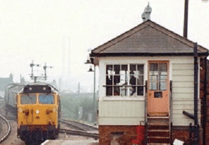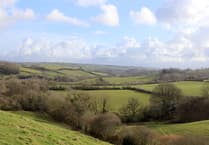DAVIDSTOW Moor RAF Memorial Museum welcomed its German guests to the rather iconic shed of Philip Jenkinson on a recent summer’s day, writes Helen Pusey.
Philip Jenkinson was only 18 when he enlisted in the RAF. He was later selected for aircrew while on his first posting in Blackpool. He was sent to Bridlington Initial Training Wing. He passed exams to work overseas.
Before he knew it he was on a train to Cardiff and then a ship called ‘Cavina’ and bound for Halifax, Nova Scotia. Once in Canada he went back on the RMS Queen Elizabeth, which was being used as a troop ship at that time. He flew training flights in Whitley’s.
After training Philip was sent to 10 Squadron where he went on active service flying in four engined Halifax aircrafts to Germany and Italy as a mid Upper Gunner. It was on his tenth trip he was hit and had to parachute out.
He landed in a field near Welden, a village with around 100 residents. He heard and spotted other parachutists around him.
They too had been shot down but the rear gunner and the pilot had died. The remaining men carefully buried their parachutes and kept safe by hiding in the woods and avoiding the villages for fear of capture.
Philip’s plane crashed on a farm where Mary-Beth Waldhoer’s mother had been. She learned about Philip from her mother, and was keen to visit the museum with her husband, Hans.
Mrs Waldhoer said: “I would like to donate a map to the shed to enhance the story of Philip further. It is very helpful to understand where his parachute came down.
“They all had walked in a circle and avoided the villages because of being captured. Philip also avoided landing in the lakes, as he could not swim.
“Kevin Murphy, the navigator heard the bells of the church and was afraid he would parachute into it and landed in a field too. Kevin was captured in Leeder. He had the bed of the mayor’s daughter for the first night!”
The men had continued to move in darkness and shadows. They became hungry, as not everyone had their ration packs and emergency kits. Thirst was even more of a concern and they found themselves drinking from puddles on the roads when the coast was clear.
They survived this way for nine days and were very close to the Swiss border when German soldiers captured them at Immenstadt.
Philip was taken to a Prison of War camp called Stalagluft 6 Heydekrug. This was a camp especially for RAF Non-Commissioned aircrew.
Mrs Waldhoer said that Philip had told her that during this time, selected officers, himself included were put on trains to Munich, following the raids there, so they could see the damage they had done.
He was taken to the Opera House where the roof was missing. All the officers thought they were going to be shot afterwards as Military Commander, Hermann Goring, was due to attend but later declined, so they were taken to Furstenfeldbruck (Fursty), which is still an air station to this day.
It is another new piece of history to add to this exciting story which until now had never come to light as it was not documented anywhere in Germany.
Philip remained at the concentration camp until the end of the war. He died in 2011 but kept all his artefacts from this time in his life under the stairs. He passed them onto Graham Lewis, who is a plane site archaeologist at the museum. He decided to display them in a most honourable shed dedicated to Philip.
Mr Lewis said: “ Following this visit from Mr and Mrs Waldhoer I am planning a visit to the field where Philip’s plane came down as there’s still some pieces of the aircraft there.”
The shed also pays tribute to Philip’s brother who had been determined to join the RAF despite pleurisy. Unknown to Philip he had become a Flight Sergeant but was killed in 1945.
It was only when Philip was paying his respects at the grave of the Halifax Pilot and Rear Gunner he noticed his brother’s grave behind his old crew mates.
For those who have a passion for the Second World War, heroes and amazing sheds, they will not be disappointed if they visit the shed, bursting at the seams with information about this true story.
Museum opening times are Monday to Sunday 10am to 4pm until the end of September.




